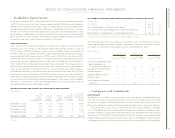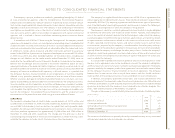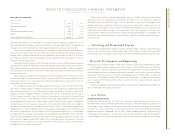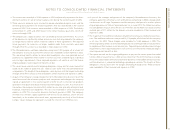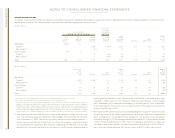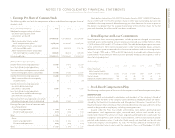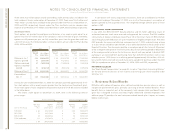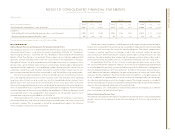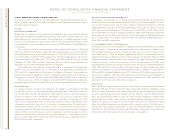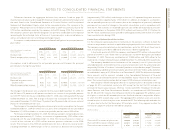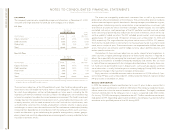IBM 2004 Annual Report Download - page 81
Download and view the complete annual report
Please find page 81 of the 2004 IBM annual report below. You can navigate through the pages in the report by either clicking on the pages listed below, or by using the keyword search tool below to find specific information within the annual report.
NOTES TO CONSOLIDATED FINANCIAL STATEMENTS
79
International Business Machines Corporation and Subsidiary Companies
ibm annual report 2004
(Dollars in millions)
U.S. Non-U.S. Total
FOR THE YEAR ENDED DECEMBER 31: 2004 2003 2002 2004 2003 2002 2004 2003 2002
Total retirement-related plans—cost /(income) $«827 $««««67 $«(154) $«617 $«295 $«(17) $«1,444 $«362 $«(171) *
Comprise:
Defined benefit and contribution pension plans— cost/(income) $«500 $«(227) $«(478) $«572 $«254 $«(46) $«1,072 $«««27 $«(524)
Nonpension postretirement benefits— cost 327 294 324 45 41 29 372 335 353
*Includes amount for discontinued operations cost of $77 million for 2002.
accounting policy
Defined Benefit Pension and Nonpension Postretirement Benefit Plans
The company accounts for its defined benefit pension plans and its nonpension post-
retirement benefit plans using actuarial models required by SFAS No. 87, “Employers’
Accounting for Pensions,” and SFAS No. 106, “Employers’ Accounting for Postretirement
Benefits Other Than Pensions,” respectively. These models use an attribution approach that
generally spreads individual events over the service lives of the employees in the plan.
Examples of “events” are plan amendments and changes in actuarial assumptions such as
discount rate, rate of compensation increases and mortality. The principle underlying this
required attribution approach is that employees render service over their service lives on
a relatively smooth basis and therefore, the income statement effects of pensions or non-
pension postretirement benefit plans are earned in, and should follow, the same pattern.
One of the principal components of the net periodic pension cost/(income) calcula-
tion is the expected long-term rate of return on plan assets. The required use of expected
long-term rates of return on plan assets may result in recognized pension income that is
greater or less than the actual returns of those plan assets in any given year. Over time,
however, the expected long-term returns are designed to approximate the actual long-term
returns and therefore result in a pattern of income and expense recognition that more closely
matches the pattern of the services provided by the employees. Differences between actual
and expected returns are recognized in the calculation of net periodic pension cost/
(income) over five years as provided for in SFAS No. 87.
These expected returns on plan assets are developed by the company in conjunction
with external advisors, and take into account long-term expectations for future returns and
investment strategy. This assumption is tested for reasonableness against the historical
return average, usually over a ten-year period.
The discount rate assumptions used for pension and nonpension postretirement bene-
fit plan accounting reflect the prevailing rates available on high-quality, fixed-income debt
instruments with maturities that match the benefit obligation. The rate of compensation
increase is another significant assumption used in the actuarial model for pension
accounting and is determined by the company, based upon its long-term plans for such
increases. For retiree medical plan accounting, the company reviews external data and its
own historical trends for health care costs to determine the health care cost trend rates.
As required by SFAS No. 87, for instances in which pension plan assets are less than
the accumulated benefit obligation (ABO) as of the end of the reporting period (defined
as an unfunded ABO position), a minimum liability equal to this difference is recognized in
the Consolidated Statement of Financial Position. The ABO is the present value of the actu-
arially determined company obligation for pension payments assuming no further salary
increases for the employees. The offset to the minimum liability is a charge to equity, net
of tax. In addition, any prepaid pension asset in excess of unrecognized prior service cost
must be reversed through a net-of-tax charge to equity. The charge to equity is included in
the Accumulated gains and (losses) not affecting retained earnings section of Stockholders’
equity in the Consolidated Statement of Financial Position.
The company uses a December 31 measurement date for the majority of its pension
plans and nonpension postretirement plans.
Defined Contribution Pension Plans
The company records pension expense for defined contribution plans when the employee
renders service to the company, essentially coinciding with the cash contributions to
the plans.


